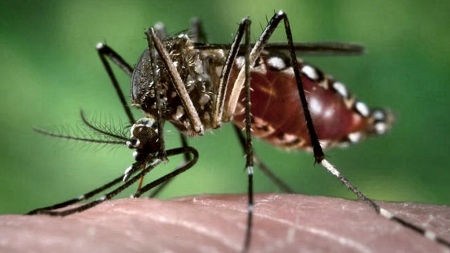There are approximately 3,500 species of mosquitoes in the world, of which some 246 live in Argentina. The aedes aegypti is under scrutiny, not only because of the diseases it transmits such as dengue -also known as “bonebreaker”-, chikungunya, zika and yellow fever, but also because of its ability to adapt to temperate climates and low temperatures.
Fabrizio Tejerina is a biologist and has been a member of the Research Group on Mosquitoes in Argentina (Gima) that in November it will have a new conclave in the province of San Juan, the first face-to-face meeting after two years of the Covid-19 pandemic.
“The mosquito is the most investigated after homo sapiens. Science knows a lot but unfortunately these diseases continue to advance because they have to do with social conditions and with how we generate favorable conditions for this mosquito to adapt to the places where we live”, explains the scientist in dialogue with Télam-Confiar.
Currently, Tejerina is in charge of the Institute of Epidemiological Surveillance and Vectors of the Municipality of Posadas, in the province of Misiones, from where she works for the elimination of breeding sites to avoid another outbreak. In Argentina, the last one was in 2019-2020, with almost 54 thousand cases.
In which parts of the country is the vector present?
There is always talk of tropical and subtropical diseases, but in the last ten or fifteen years the distribution of the mosquito has spread further to the south of Argentina, reaching La Pampa, south of the province of Buenos Aires, and the Cuyo region. Places where it was not registered are now registering and presenting the vector. Moreover, in 2020, a major outbreak in the capital of La Rioja drew attention in the midst of a pandemic. According to official data, La Rioja reported the same number of dengue cases as Misiones: about 10,000.
All the conditions that man favors are those structures that we leave for the mosquito to reproduce, such as the places where water is preserved; For its part, climate change and increased temperatures (also caused by human actions) make the mosquito begin to conquer new places. Being in new places, anyone who arrives sick and is stung can start an outbreak of dengue, and thus the risk spreads.
It means that the mosquito is adapting to other places, for example, to areas with a temperate or cold climate…
It is adapting and beginning to find places where conditions are changing and finding ecological niches that it can conquer. If we look around the world, more than two million people are in tropical or subtropical places where Aedes aegypti is. But it is also a risk in temperate zones. In Córdoba, for example, there has been a major outbreak in recent years.
The danger of the mosquito is associated with the environmental conditions that favor its presence. As well as climate change, what it does is shorten winters in some places and prolong hot moments. We know that the biology and cycle of insects is closely associated with temperature, they need heat, so the more heat there is, the more they reproduce.
How is the reproduction of the vector and how to avoid it?
We always say that there are no mosquitoes in winter, but in general they have a form of resistance that is the eggs. The mosquito population increases during the summer, it reaches its peak in March and those millions of mosquitoes lay millions of eggs. Each mosquito can lay up to 100 to 300 eggs; and those eggs, not having the conditions when the cold begins, spend the whole winter waiting for the conditions to improve. And when this happens, they hatch and start reproducing again. This again increases the population of the vector.
Eggs are very easy to remove from containers. If one finds a container accumulated with water, it is necessary to throw away the water, brush, rinse and turn it over so that it does not accumulate water again. It is a mosquito that has adapted very well to any artificial container, for example, we often find it in gutters. The population has to go looking and eliminate those mosquito breeding places.
The greater the number of places that accumulate water, the greater the probability that there will be breeding sites, the greater the number of mosquitoes, and in turn, the greater the probability that they will bite a sick person.
There is talk of studies that analyze the possibility that the mosquito is born with the virus. Something that some time ago was impossible, since the vector could only be spread by biting a sick person…
We are working with a virological team in Córdoba, an investigation that was approved a few months ago, to see how important this hypothesis is in the cycle of the virus. One thing is the cycle of the mosquito and its adaptation, but the virus also mutates and adapts. What we say from science is that the vertical transmission of mosquito mother to eggs had been calculated by laboratory study one per thousand. That is, infected female mosquito for every thousand eggs that she laid, one came out infected. Because we found the male infected, and the only way for the male to get infected is if the mother has infected him. The male Aedes does not bite, only the female bites.
So it is being seen if this adaptation of the virus passing from mother to child is so low the probability or if that probability is increased. It is a question that we ask ourselves and further complicates the situation.
On what premise are epidemiologists and researchers in general based who issue an alert due to the risk of a dengue outbreak in Argentina?
What we can see are the statistics of Brazil. They published figures from January to July, showing that in 2022 they had twice as many cases as in 2021 and more than twice as many deaths as in 2021.
In 2021 they had 250 deaths and now they have 510 dengue deaths. So, they suggest that this scenario is very similar to what happened in 2015; so you have to remember what happened in 2016 in Argentina. What happens in Brazil can have repercussions in Argentina.











